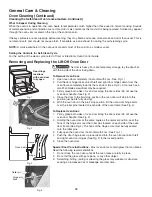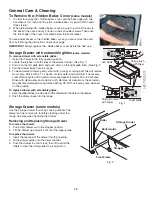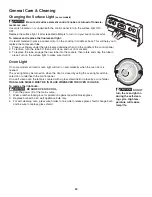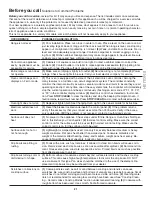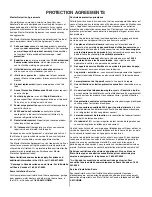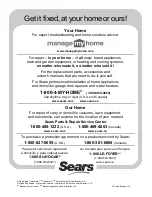
14
General Care & Cleaning
Cleaning Various Parts of Your Range
Before cleaning any part of the range, be sure all controls are turned OFF and the range is COOL. REMOVE SPILLOVERS
AND HEAVY SOILING AS SOON AS POSSIBLE. REGULAR CLEANING WILL REDUCE THE NUMBER OF MAjOR
CLEANING LATER.
Surfaces
How to Clean
Aluminum & Vinyl
Use hot, soapy water and a cloth. Dry with a clean cloth.
Painted and Plastic Control
Knobs, Body Parts, and
Decorative Trim
Using a soft cloth, clean with mild dish detergent and water or a 50/50 solution of
vinegar and water. Follow by rinsing the area with clean water; dry and polish with a soft
cloth. Glass cleaners may be used if sprayed on a soft cloth first.
DO NOT spray liquids
directly on the control pad and display area. Do not use large amounts of water on the
control panel - excess water on the control area may cause damage to the appliance.
Do not use other liquid cleaners, abrasive cleaners, scouring pads, or paper towels -
they will damage the finish. To remove control knobs, turn to the
OFF position; grasp
firmly and pull straight off the shaft. To replace knobs after cleaning, line up the flat sides
of both the knob and the shaft; then push the knob into place.
Stainless Steel (some
models) Oven Door &
Drawer Front Panel and
Decorative Trim
Stainless Steel (some models) Oven Door & Drawer Front Panel and Decorative Trim
Surface Elements and Drip
Bowls (some models)
Surface elements can be unplugged and removed to make cleaning the drip bowls eas-
ier. The surface elements clean themselves when they are turned on. Food spilled on
a hot element will burn off. Food spilled on a cold element can be cleaned with a damp
cloth any remaining soil will burn off the next time element is used.
NEVER IMMERSE
A SURFACE ELEMENT IN WATER. To remove surface element and drip bowls, follow
the instructions under
General Cleaning.
To clean drip bowls, wash in hot, soapy water or in the dishwasher. Rinse and dry while
still warm. Hard-to-remove, burned-on soils can be removed by soaking the drip bowls
for about 20 minute in a slightly diluted liquid cleanser or solution made of equal parts
ammonia and water. A nylon scrubber may be used after soaking.
DO NOT use abra-
sive cleanser or steel wool, as they will scratch the surface. Always rinse with clean
water and polish, and dry with a soft cloth. To replace drip bowls and surface elements,
follow the instructions under
General Cleaning.
Porcelain Enamel
Broiler Pan and Insert (some
models), Cooktop, Surface
under Cooktop, Door Liner,
Body Parts and Warmer
Drawer and Drawer Cavity
Gentle scouring with a soapy scouring pad will remove most spots. Rinse with a 1:1
solution of clear water and ammonia.
If necessary
, cover difficult spots with an ammo-
nia-soaked paper towel for 30 to 40 minutes. Rinse with clean water and a damp cloth,
and then scrub with a soap-filled scouring pad. Rinse and wipe dry with a clean cloth.
Remove all cleaners or the porcelain may become damaged during future heating.
DO
NOT use spray oven cleaners on the cooktop.
Oven Racks
Oven racks should be removed, or else their finish will dull and their color turn slightly
blue. If they do go through the self-clean cycle, wait until the oven has cooled, then
remove the oven racks and rub their sides with wax paper or a cloth containing a small
amount of baby or salad oil; this will make the oven racks glide easier back in and out of
their positions.
Oven door
Do Not
Hand
Clean Seal
Do Hand
Clean Frame
Do Hand
Clean Door
To clean oven door, wash with hot, soapy water and a clean cloth. DO NOT immerse
the door in water.
DO NOT clean the oven door gasket. The oven door gasket is made of a woven mate-
rial, on self cleaning models, which is essential for a good seal. Care should be taken
not to rub, damage or remove the gasket.


















